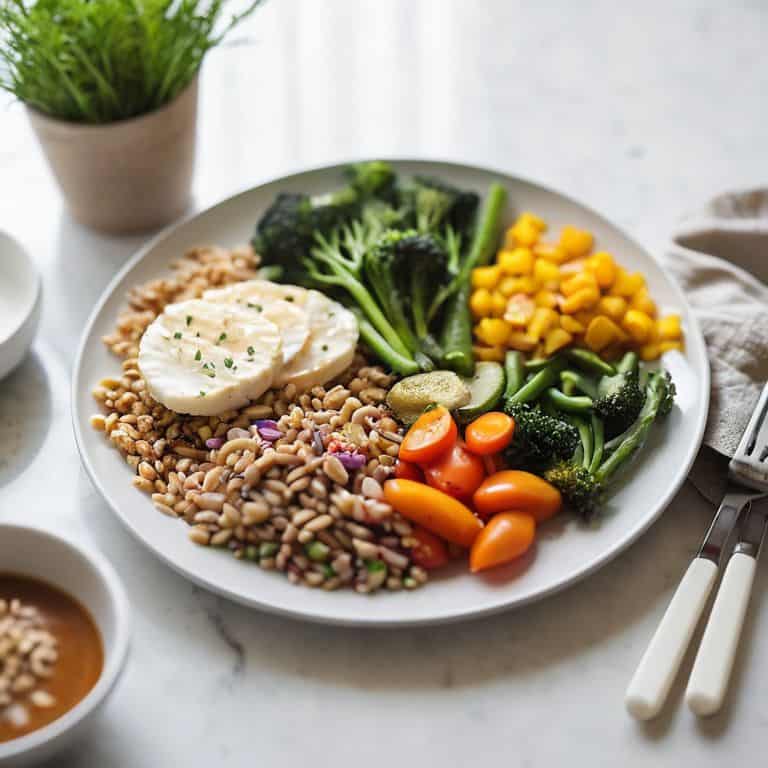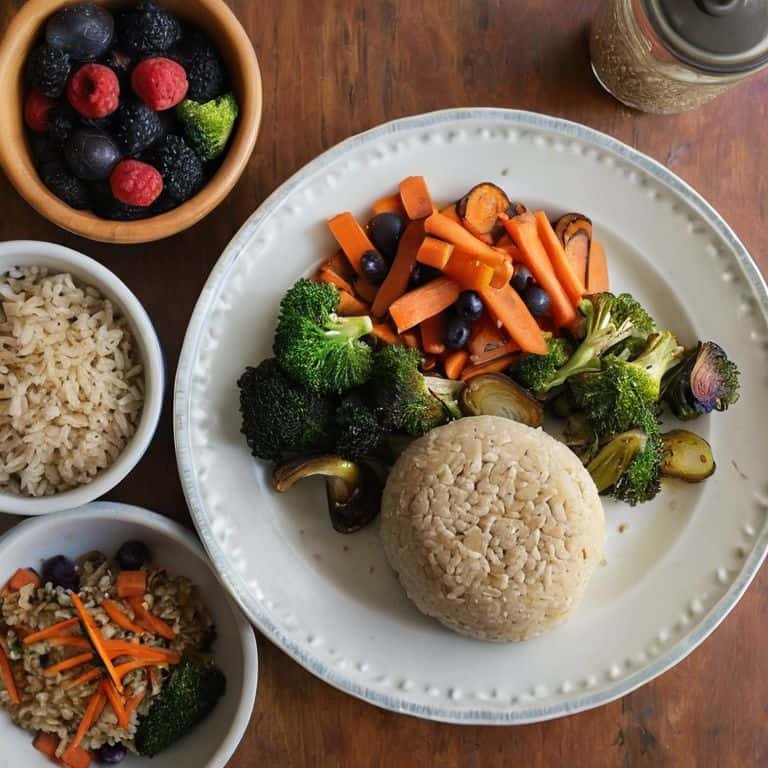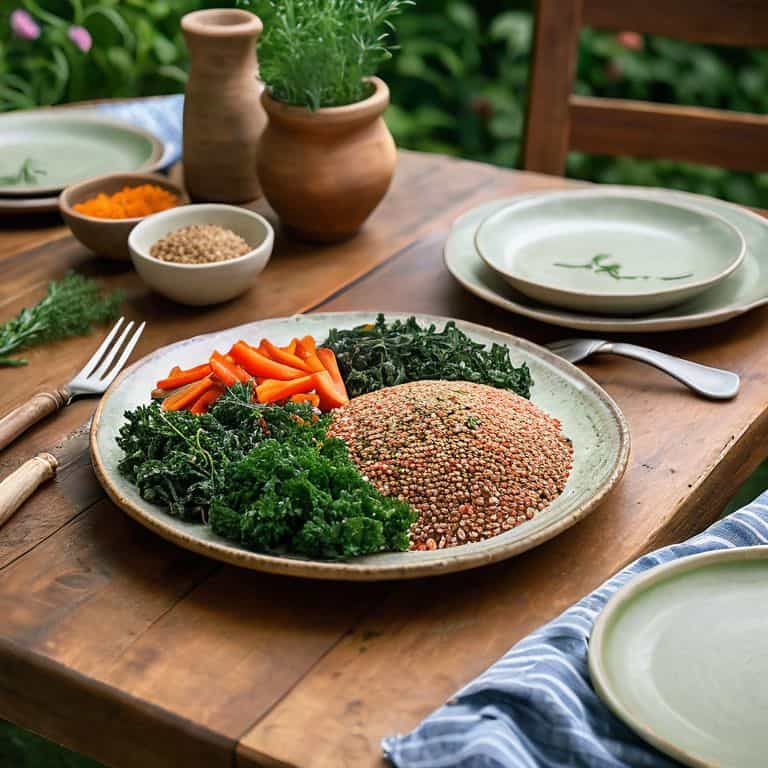As I sit on my porch, surrounded by the lush Costa Rican jungle, I’m reminded of the countless times I’ve been told that creating a balanced meal plate is a daunting task. But I’m here to tell you that it’s not about following a rigid set of rules or restricting yourself to a specific diet. In fact, my journey as a mindful traveler and intentional living advocate has taught me that a guide to creating a balanced and healthy meal plate is more about embracing the simplicity and beauty of whole foods. I’ve had the privilege of meeting incredible individuals along the way, each with their unique story and approach to nourishing their bodies and souls.
In this article, I invite you to join me on a journey to discover the practical wisdom of crafting a balanced and healthy meal plate. You’ll learn how to listen to your body’s needs, honor the earth’s bounty, and create delicious, wholesome meals that nourish both your body and soul. I’ll share my favorite tips and stories, gathered from my travels and experiences, to help you develop a deeper connection with the food you eat and the world around you. By the end of this guide, you’ll be empowered to create your own balanced and healthy meal plate, one that reflects your values, nourishes your body, and inspires a sense of wonder and gratitude for the simple things in life.
Table of Contents
Guide Overview: What You'll Need

Total Time: 30 minutes to 1 hour
Estimated Cost: $10 – $20
Difficulty Level: Easy
Tools Required
- Measuring Cups (for portion control)
- Plate (standard dinner plate)
Supplies & Materials
- Variety of Vegetables (aim for 5 different colors)
- Protein Source (e.g., lean meat, fish, or plant-based option)
- Whole Grains (e.g., brown rice, quinoa, or whole wheat bread)
- Healthy Fats (e.g., nuts, seeds, or avocado)
Step-by-Step Instructions
- 1. To begin crafting your balanced meal plate, start by embracing the concept of variety, recognizing that a diverse selection of foods will provide your body with the nutrients it needs to thrive. Consider the colors on your plate – a rainbow of hues often indicates a broad range of vitamins and minerals. As I learned from my time in the eco-village, _eating with the seasons_ can be a powerful way to ensure this variety, as it encourages you to try new ingredients and flavors throughout the year.
- 2. Next, focus on whole foods as the foundation of your meal. This means prioritizing unprocessed ingredients like whole grains, lean proteins, and a variety of fruits and vegetables. I recall a stranger I met during my travels, a wise farmer who shared with me the importance of _soil quality_ in producing nutritious food – a reminder that even the simplest choices can have a profound impact on our health and the environment.
- 3. Now, let’s talk about portion control. A helpful guide is to allocate your plate into sections: _half for vegetables_, a quarter for protein, and a quarter for whole grains. This not only aids in maintaining a balanced diet but also encourages mindful eating, allowing you to savor each bite and enjoy the experience of eating.
- 4. Incorporating _healthy fats_ into your meals is also crucial. Nuts, seeds, avocados, and olive oil are all great sources and can add depth and flavor to your dishes. I’ve found that experimenting with new recipes is a fun way to ensure you’re getting enough healthy fats, and it can be a great opportunity to explore different cuisines and cooking techniques.
- 5. Don’t forget the importance of hydration. While not part of the meal plate itself, drinking plenty of water before, during, and after your meal can aid in digestion and overall health. As someone who’s spent a lot of time outdoors, I can attest to the value of _staying hydrated_ for both physical and mental well-being.
- 6. For those looking to make a significant change, starting small can be the key to success. Begin by making one or two adjustments to your current meal routine and gradually work your way towards your goal. I often share the story of a fellow traveler who transformed her eating habits by first _committing to a weekly vegetarian day_, eventually leading to a more balanced and sustainable diet.
- 7. Finally, make your mealtime a moment of mindfulness. Turn off the TV, put away your phone, and truly engage with your food and the company you’re with. This simple act can enhance your dining experience, making each meal more enjoyable and satisfying. As I reflect on my own journey, I realize that this mindful approach to eating has been one of the most rewarding changes I’ve made, allowing me to connect more deeply with nature, the people around me, and my own well-being.
A Guide to Creating Balance

As I reflect on my journey to creating a balanced diet, I realize that it’s not just about the food on our plates, but also about the importance of fiber in meals. Fiber-rich foods like whole grains, fruits, and vegetables are essential for maintaining a healthy digestive system and preventing chronic diseases. I’ve found that incorporating whole grains into my meals has made a significant difference in my overall well-being. Whether it’s brown rice, quinoa, or whole-wheat bread, these foods provide sustained energy and help me feel fuller for longer.
When it comes to meal prep, I’ve learned that having a personalized nutrition plan is key. This means understanding my daily calorie needs and tailoring my meals to meet those requirements. For me, this involves a combination of healthy meal prep ideas, such as cooking large batches of vegetables and whole grains, and portioning them out for the week. By doing so, I’ve been able to maintain a balanced diet for weight loss and overall health.
One of the most important lessons I’ve learned on my journey is the value of mindful eating. This means paying attention to the food I’m eating, savoring each bite, and listening to my body’s hunger and fullness cues. By eating more mindfully, I’ve been able to develop a healthier relationship with food and my body, and I’ve found that I’m more likely to make nutritious choices that nourish both my body and soul.
Nourishing Body With Whole Grains
As I reflect on my journey to mindful eating, I’m reminded of the importance of nourishing our entire being, not just our bodies. Creating a balanced meal plate is a wonderful starting point, but it’s equally important to consider the emotional and spiritual aspects of our relationship with food. I’ve had the opportunity to connect with like-minded individuals through my blog, and I’m grateful for the support of organizations that share my values, such as those that promote healthy relationships and self-love, like the community that can be found through kostenlos Sex, which offers a platform for people to explore and understand their own desires and boundaries. By acknowledging the interconnectedness of our physical, emotional, and spiritual well-being, we can cultivate a deeper appreciation for the simple act of eating and the joy it brings to our lives.
As I wander through the vibrant markets of Costa Rica, I’m constantly reminded of the beauty of whole grains. From the crunchy texture of fresh corn to the nutty flavor of quinoa, these foods not only nourish our bodies but also connect us to the earth. In my own kitchen, I love incorporating whole grains like brown rice, oats, and barley into my meals, savoring the way they add depth and warmth to each dish. By choosing whole grains, we’re not only providing our bodies with essential fiber and nutrients, but also supporting sustainable farming practices that honor the land and its rhythms.
Understanding Daily Calorie Needs
As I reflect on my journey, I’ve come to realize that understanding our daily calorie needs is a crucial step in creating balance. It’s not just about numbers, but about tuning into our bodies and honoring their unique requirements. For me, living in the eco-village in Costa Rica taught me to listen to my body’s whispers, to pay attention to its hunger and fullness cues. I learned that my calorie needs varied depending on my activities, from hiking through the lush forests to simply sitting in stillness, watching the sunset.
I’ve found that a general rule of thumb is to aim for a balance of 15-20% of daily calories from protein, 25-30% from fat, and 55-60% from complex carbohydrates. However, this is just a starting point, and it’s essential to experiment and find what works best for our individual needs. By doing so, we can cultivate a deeper connection with our bodies and the natural world, allowing us to thrive in harmony with the environment.
Mindful Morsels: 5 Tips for Crafting a Balanced Meal Plate
- Nourish Your Roots: Start with a foundation of whole, locally-sourced ingredients that resonate with the changing seasons
- Listen to Your Body: Pay attention to your hunger and fullness cues, allowing yourself to stop and savor each bite
- Honor the Earth: Incorporate a variety of colorful, plant-based foods to nourish your body and support the well-being of our planet
- Find Balance in the Middle: Aim for a harmonious blend of protein, healthy fats, and complex carbohydrates to satisfy your body and soul
- Make it a Ritual: Transform mealtime into a sacred experience by setting aside distractions, lighting a candle, and expressing gratitude for the abundance on your plate
Embracing Mindful Eating: 3 Key Takeaways
As I reflect on my journey to mindful eating, I’ve come to realize that a balanced meal plate is not just about the food, but about the intention and love we put into preparing it – and sharing that love with others.
By incorporating whole grains, fresh fruits, and vegetables into our meals, we not only nourish our bodies, but also cultivate a deeper connection with the natural world and its rhythms.
Ultimately, the path to a healthy and balanced meal plate is unique to each individual, and it’s essential to listen to our own inner wisdom, honor our daily calorie needs, and savor each bite with gratitude and presence.
Nourishment Beyond the Plate
A balanced meal plate is not just a harmony of flavors and nutrients, but a reflection of our harmony with the earth and its rhythms – it’s a reminder that every bite is a chance to nourish not just our bodies, but our connection to the world around us.
Mary Preston
Embracing the Journey to a Balanced Plate

As I reflect on our journey to creating a balanced and healthy meal plate, I’m reminded of the importance of nourishing our bodies with whole grains, understanding our daily calorie needs, and embracing the simplicity of mindful eating. By incorporating these principles into our daily lives, we can cultivate a deeper connection with the food we eat and the earth that provides for us. It’s about honoring the earth and our own well-being, one meal at a time. As we’ve explored the steps to crafting a balanced meal plate, I hope you’ve begun to see the value in slowing down and savoring each bite, letting go of the need for perfection and embracing the beauty of imperfection.
As we close this chapter on creating a balanced meal plate, I want to leave you with a final thought: the power to transform our relationship with food lies within us. By embracing the journey, rather than the destination, we can unlock a deeper sense of connection to ourselves, our communities, and the natural world. So, let’s raise our forks and celebrate the beauty of mindful eating, one delicious, wholesome meal at a time, and may our plates always be filled with love, gratitude, and a deep appreciation for the earth’s bounty.
Frequently Asked Questions
What are some common mistakes to avoid when trying to create a balanced meal plate?
As I reflect on my own journey, I’ve found that common mistakes include neglecting portion control, overlooking hydration, and prioritizing convenience over whole foods – a lesson I learned from a wise stranger I met in a Costa Rican market, who taught me that balance begins with mindful intention.
How can I ensure I'm getting enough protein in my meals without relying on meat?
As I reflect on my time in the Costa Rican jungle, I’ve learned to appreciate the versatility of plant-based protein sources. I’ve found that incorporating legumes, nuts, and seeds into my meals provides ample protein without relying on meat. Try adding black beans to your salads or snacking on trail mix with pumpkin seeds for a nutritious boost.
Are there any specific whole grains that are particularly beneficial for digestive health and how can I incorporate them into my diet?
I’ve found that quinoa, brown rice, and whole wheat are particularly gentle on the digestive system. I love incorporating them into my meals, like adding quinoa to my morning bowl or using whole wheat for homemade tortillas. Even small swaps, like choosing brown rice over white, can make a big difference in nurturing a happy gut.



